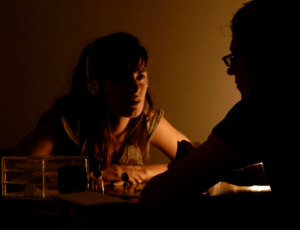‘Offers them opportunity to open their senses to the land they are living in/on, and participate, physically immerse in it. It invites them to pay attention to what they pay attention to.’ (Taylor, 2008, p. 140)
In everyday life, we naturally use our senses to get by. We use them to see, hear, taste, smell and feel the world around us. It’s instinctive. However, in relation to theatre, the exploration and experimentation of these senses is quite intriguing as well as extremely challenging for a performer, director and audience member. Theatre is normally regarded as a visual and auditory art, whether that’s concentrated on performers in a physical dance piece or the elaborate set design of an award-winning production, intertwined with pieces of music and the spoken voice. During last week and into this week, we have all been learning how all five senses can be explored in relation to theatre and in particular, how we would incorporate this concept to our developing performances within this site.
After discussing the possibilities of fusing experimentation of the senses into our growing drama piece, the whole group were given the task to present a 5-10 minute piece in our next site visit which integrated our thoughts and ideas. We felt inspired by what we had learnt in lesson from various practitioners and companies performances so looked forward to adding this to our performance idea of ‘Waiting Room’ (More details about specific performances ideas to follow).
On site, we set out chairs as in the shape of a general waiting room, placing an envelope on the majority of chairs. These envelopes held instructions to the individual who chose to sit there, for example ‘Open at 11.34am’ or ‘Open when you hear crying’ were written on the front of the envelope and inside another instruction would be given such as ‘Put the kettle on, pour water into mug and give to another audience member’.


The use of these envelopes allowed us to be in control of the piece and directly see how the notion of ‘senses’ could be an interesting part of the ‘Waiting Room’. Just from these 2 example instructions, the use of smell, touch, sight, audio and perhaps taste (depending if the audience member drank the coffee) are evident:
SIGHT: The dependence on keeping an eye on the clock to know when to open certain envelopes, to read the instructions given, to see the other audience members partaking in their tasks.
SMELL: The smell of coffee that was being made by an individual participant, the perfume we sprayed on the seats and envelopes before the audience members came in.
SOUND: Sound of kettle boiling, sound of crying, sound of scratching pens on a writing pad.
TOUCH: More to do with ‘feeling’- turning all the heaters off so that the room was uncomfortably cold. The contrast between the cold room and the hot coffee mug and individual was given.
TASTE: Again perhaps for an audience member who may drink the coffee.
After presenting to the class and receiving feedback, we felt that this concept is something that we would like to build upon because of how much it contributed to the atmosphere, creating an interesting dimension to the piece. Participants agreed with this and said that it gave a heightened atmosphere from the start due to the temperature of the room and pressure of fulfilling a given task. We could see for ourselves how this made audience members feel different (uncomfortable, unsafe, unsure) in comparison to viewing other performances, both individually and as a whole group of people.
Our main inspiration was Rotozaza’s ‘Etiquette’ due to the focus on an individual/pair’s reaction to the experimentation of their senses. This 30 minute ‘experience’ is an example of how auditory given tasks challenge the audience members by exposing ‘human communication at both it’s rawest and most delicate’ (Rotozaza, 2007) through the use of headphones.

Captured in Buenos Aires by Nicholas Goldberg.
Etiquette. Online: http://www.rotozaza.co.uk/etiquette2.html [Accessed on 10 March 2014]
‘If the line between audience and performer seems blurred, Rotozaza’s ‘Etiquette’ erases it entirely’ (ibid). Etiquette uses the participants as the entire basis for the performance and this is something that we wanted to make evident in our presentation. The whole 10 minute piece relied on our participants to open and fulfill their tasks which led to others opening their envelopes and so on. This brought quite a fresh atmosphere to the piece as a whole as nothing was completely definite, perhaps allowing for many exciting undefined circumstances.
To develop this concept in our idea of the ‘Waiting Room’, we will need to focus on more means of reacting with participant’s senses whilst considering about how this can relate to the context and content of our ideas and what we want to perform.
References:
Rotozaza (2007) Etiquette- Rotozaza’s Micro/Autoteatro Work, Online: http://www.rotozaza.co.uk/etiquette2.html [Accessed 10 March 2014]
Taylor, G (2008) Locating: Place and the Moving Body. PhD. Victoria University, AUS. Online: http://mams.rmit.edu.au/q6n0m9ah9rvcz.pdf [Accessed 10 March 2014]




